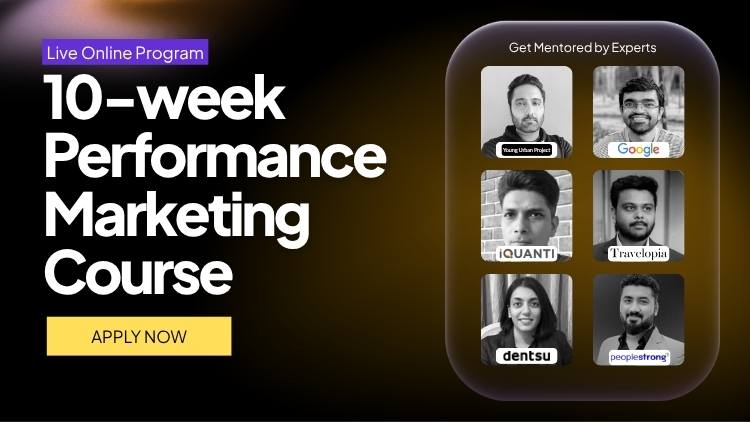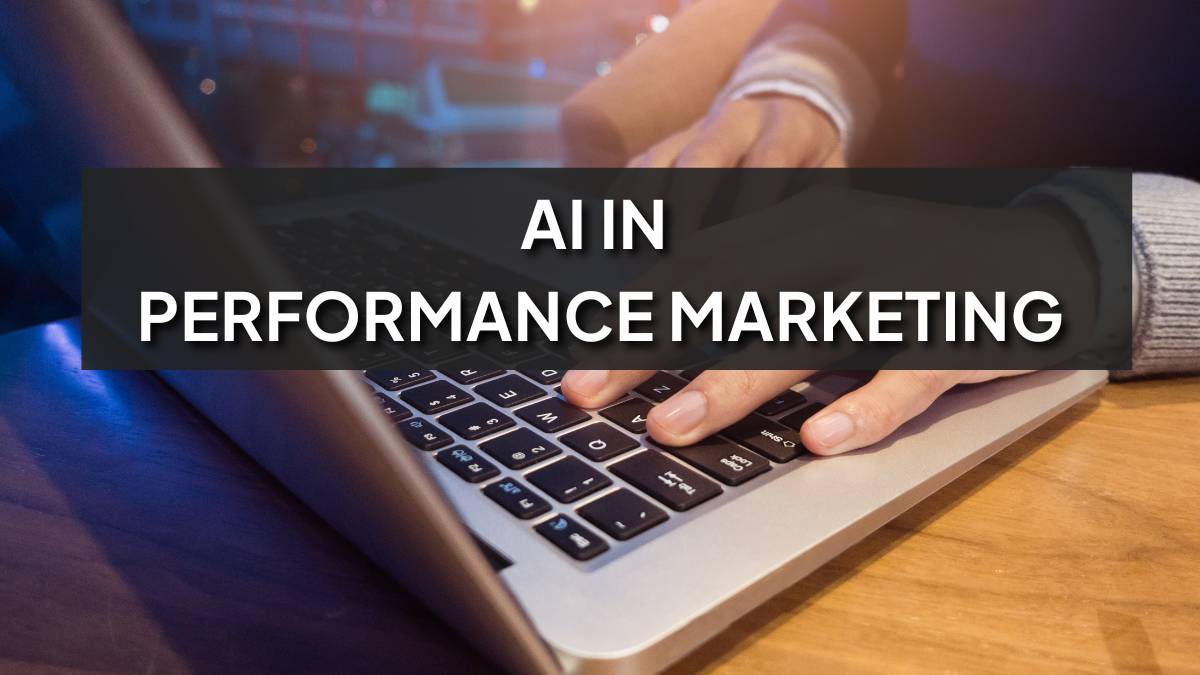Let’s be honest, marketing has changed a lot in the past few years.
If you’ve run any kind of digital ad campaign recently, you’ve probably noticed that things feel a bit… different. Platforms are smarter. Targeting is more precise. And somehow, results are improving even when you’re not tweaking every little thing manually.
That’s because AI is doing more and more of the work now, often without you even realizing it.
From how we build audiences to how much we spend on each click, AI in performance marketing is reshaping how we approach digital advertising. And no, this isn’t some futuristic concept. It’s already happening, inside your Google Ads account, in your Meta campaigns, and across pretty much every ad platform that matters.
Table of Contents
What is Performance Marketing, and where does AI come in?
So let’s back up a second.
Performance marketing is basically a style of advertising where you only pay when something happens. A click. A sign-up. A sale. It’s very results-driven, none of that “let’s just get some brand awareness and hope for the best” stuff.
It’s all about performance. You run ads. You measure. You scale what works. Simple, right?
Now, where AI fits in… that’s where things get interesting.
In the old days (and honestly, not that long ago), performance marketers had to do everything manually. You’d launch five ad sets, test a bunch of creatives, adjust bids every other day, and hope your instincts were good.
Now? AI takes over a big chunk of that work.
You’re probably already using it without thinking about it. Google’s Smart Bidding? That’s AI. Facebook’s Advantage+ campaigns? Yep, AI again. Even tools like Madgicx or Adobe Sensei, they’re all powered by machine learning models that are constantly learning what’s working and what’s not.
The goal is to make your campaigns more efficient, more targeted, and way more profitable.
How does AI make ad targeting and segmentation smarter?
This part always blows my mind a little.
Remember when we used to create audiences based on age, gender, location, and maybe a couple of interests? You’d build your “ideal customer persona” and hope you got it right.
AI does things very differently.
Instead of guessing who your audience might be, it actually learns who’s most likely to convert, by looking at tons of data. Not just what people click on, but how they browse, what they buy, how long they spend on a product page, what device they’re on, the time of day… it’s honestly wild how deep it goes.
Here’s what AI brings to the table:
- Behavior-based segmentation: It groups users not just by who they are, but how they act online.
- Lookalike audiences that actually work: AI finds patterns in your best customers, then finds new people who behave similarly, even if they seem totally unrelated on the surface.
- Real-time shifting: If someone interacts with your brand in a certain way, like visiting your pricing page twice in a day, AI might instantly change the kind of ad they see next.
Before, it took days or weeks to test and adjust for stuff like that. Now, it happens automatically.
Benefits of using AI in Performance Marketing
Okay, now we’re getting into the good stuff.
A lot of people hear “AI” and immediately think of robots taking over their jobs, but in performance marketing, AI is more like a co-pilot. It helps you make better decisions, faster, and sometimes catches stuff you would’ve completely missed.
Here’s why that matters:
- It saves time: You’re not manually pulling reports or adjusting bids every morning. AI does it for you, faster than any human could.
- It’s more accurate: Decisions are based on patterns and data, not just gut feeling.
- It personalizes everything: From headlines to product suggestions, AI knows how to serve the right ad to the right person at the right time.
- It’s better with budgets: AI constantly reallocates your ad spend based on what’s performing best, so you waste less and get more out of every rupee or dollar.
- It scales easily: Whether you’re spending ₹5,000 or ₹5 lakh, the AI systems behind major platforms adjust automatically to help you stay efficient.
Basically, you end up spending less time tweaking campaigns, and more time thinking about the big picture.
Which AI tools are actually useful for performance marketing?
This isn’t one of those “you need to go buy 10 new software tools” kind of situations.
Most of the AI features you’ll need are probably already baked into the platforms you’re using.
Here are a few that stand out:
1. Google Ads: Smart Bidding
You’ve probably seen this setting and wondered what it really does. Turns out, it uses AI to optimize bids in real-time for every single auction. So it adjusts your spend based on things like the user’s device, location, search query, and more.
2. Meta Ads: Advantage+ Campaigns
This automates a lot of the targeting and creative placement for you, and usually outperforms manual setups, especially when you don’t have a ton of data yet.
3. Madgicx
This one’s for performance marketers who want more control and insights. It uses AI to suggest creative changes, audience tweaks, and bidding strategies based on what’s actually converting.
4. Adobe Sensei
If you’re doing cross-channel stuff or working inside the Adobe ecosystem, Sensei helps you figure out what parts of your journey are working, and which ones are killing conversions.
5. Pencil / AdCreative.ai
Both tools help generate ad creatives using AI. Think of them as creative assistants that test different versions and figure out what visuals or copy is getting the best response.
You don’t need to use all of them. But even using just one or two can make a big difference in how your campaigns perform.

Also Read: AI-Powered Performance Marketing Course
Can AI actually help with ad creatives and copy?
You might think this part would still need a human touch. And yeah, for the big creative ideas, storytelling, brand voice, that’s still on us. But when it comes to testing, tweaking, and improving ad performance? AI is weirdly good at it.
Here’s how.
Let’s say you write 5 different versions of an ad. Some with a question headline, some with emojis, some super short, some long-form. Normally, you’d test each version manually, watch the results, then pick a winner. That could take weeks.
Now, AI tools can run those tests for you, learn what people are reacting to, and even suggest new versions to try. Some tools can generate fresh headlines or CTAs based on your past winners. Others can analyze which emotional tone worked better (was it urgency, curiosity, humor?) and suggest edits based on that.
A couple examples:
- Pencil: You feed it your brand assets and product info, and it makes ad videos for you, tested and ready for Meta or YouTube.
- AdCreative.ai: It’ll give you a bunch of high-performing graphic ad variations with headlines that are optimized for your audience.
It’s not about replacing your creative team. It’s more like having a testing machine that works 24/7 in the background while your team focuses on bigger things.
And honestly, once you get used to this, it’s hard to go back to doing it all manually.
Top 5 Ways AI is Powering Performance Marketing
Here’s a simple, skimmable list of where AI brings the most value right now:
- Predictive Audience Targeting
Tools like Google Analytics 4 and Adobe Sensei help you find people before they’re ready to buy, by spotting early behaviors.
- Real-Time Bid Optimization
Google and Meta automatically adjust your bids based on user intent, device, timing, etc. So you’re not overspending on low-quality traffic.
- Creative Testing & Personalization
AI tests multiple versions of your ads, images, copy, CTAs, and figures out what works for each micro-audience.
- Automated Budget Allocation
If one campaign’s tanking and another is crushing it, AI shifts your budget instantly, no need to step in manually.
- Conversion Prediction & Attribution
Machine learning identifies which touchpoints are actually driving results. So you’re not over-crediting that one Facebook ad just because it was the last click.
Also Read: Analytics in Performance Marketing
Will AI Replace Performance Marketers?
This question comes up a lot.
Short answer? No.
AI is powerful, but it doesn’t replace strategy. It doesn’t understand context the way humans do. It can’t write a brand story, come up with a bold campaign idea, or know when to ignore the data and go with your gut.
What it can do is handle the repetitive stuff. The data-crunching. The split testing. The optimization.
So instead of worrying about AI replacing marketers, think of it this way: The marketers who use AI are going to replace the ones who don’t.
If you understand how to work with these tools, when to trust them, when to override them, you’ll be way ahead of the curve.
FAQs: AI in Performance Marketing
Q1: What are the best AI tools for performance marketing?
Tools like Madgicx, Smartly.io, Adobe Sensei, and Google Ads Smart Bidding are great for automating targeting, creative testing, and bid management.
Q2: Can AI write performance marketing ad copy?
Yes. Tools like ChatGPT, Jasper, and Copy.ai can generate ad headlines, descriptions, and CTAs. You’ll still want to tweak them for tone, but they’re solid starting points.
Q3: How does AI help reduce cost in performance marketing?
AI cuts waste by automatically shifting budget, testing faster, and pausing low-performing segments. That means less trial-and-error, and better ROI.
Q4: Will AI completely replace performance marketers?
Nope. AI handles the mechanics, but humans still guide strategy, creative direction, and storytelling.
Q5: Is AI useful for small performance marketing campaigns?
Absolutely. Even small businesses benefit from AI tools that manage targeting and spend efficiently, especially when budgets are tight.

